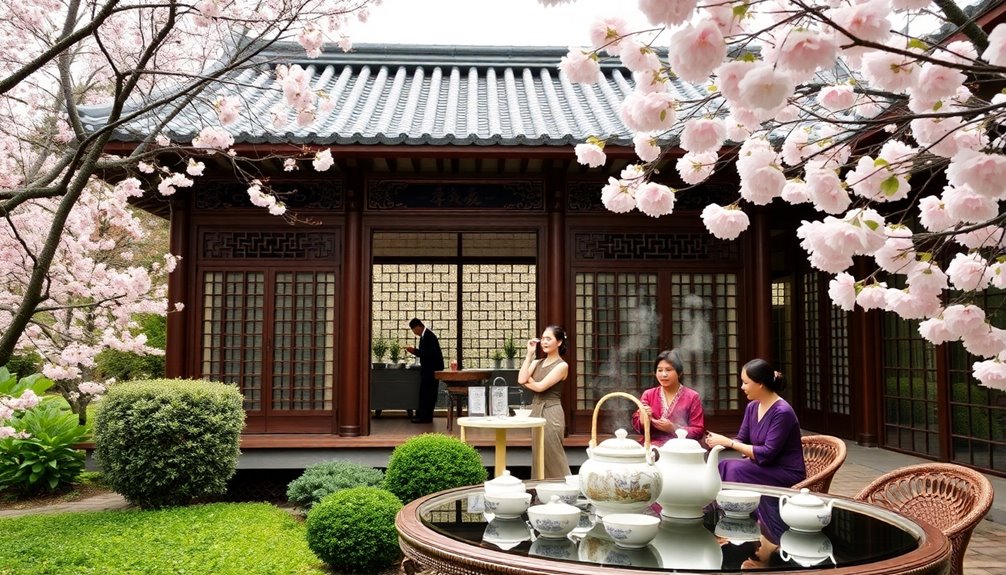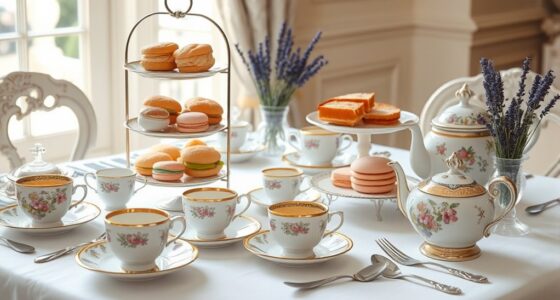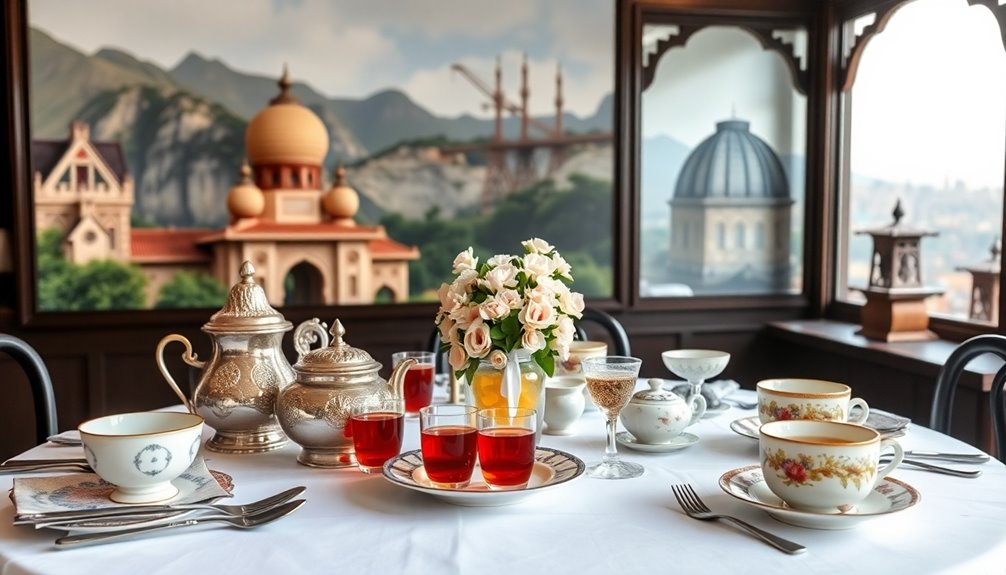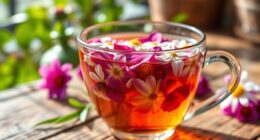To master the art of tea serving, start by understanding the tea types and their optimal brewing times; for instance, green tea brews for 2-5 minutes while black tea takes 3-7 minutes. Pay attention to serving temperatures too—black tea tastes best at 200-212°F. Use elegant vessels to enhance the visual appeal, and create a serene atmosphere with soft lighting and calming music. Remember, serving tea isn't just about the drink; it's also a way to build connections. When you embrace these simple techniques, you'll find that the experience grows richer. There's so much more to discover about this art!
Key Takeaways
- Familiarize yourself with different tea types and their optimal brewing times for a perfect cup.
- Serve tea at the ideal temperatures to enhance flavor and enjoyment for each variety.
- Use elegant vessels to elevate the visual appeal of your tea presentation.
- Create a calming atmosphere with soft lighting and soothing music for a serene experience.
- Embrace cultural traditions respectfully, understanding their significance to enhance your tea serving skills.
Introduction
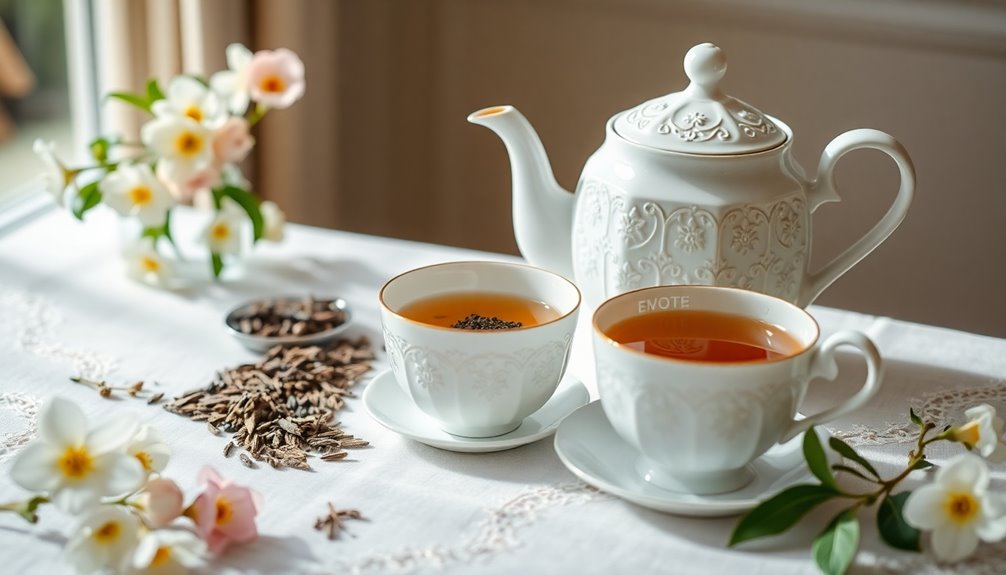
When it comes to tea serving, mastering the essentials can truly elevate your hosting skills. Your experience begins with a solid understanding of the different types of tea and the proper brewing techniques. Each tea variety has its own steeping guidelines, so familiarize yourself with them to ensure optimal flavor.
For instance, green tea typically needs 2-5 minutes, while black tea requires 3-7 minutes. Temperature matters too; serving your brewed tea at the right temperature—between 160°F to 212°F—is crucial for enjoyment.
Don't overlook presentation; elegant vessels like vintage sherry glasses or fine china can enhance the visual appeal and make your tea service memorable. Attention to detail is key in creating a serene atmosphere.
Soft lighting and calming music can transform your tea time into a relaxing ritual, encouraging mindfulness and connection. When you incorporate these elements, you not only serve tea but also immerse your guests in a rich tea culture experience.
Cultural Tea Serving Traditions
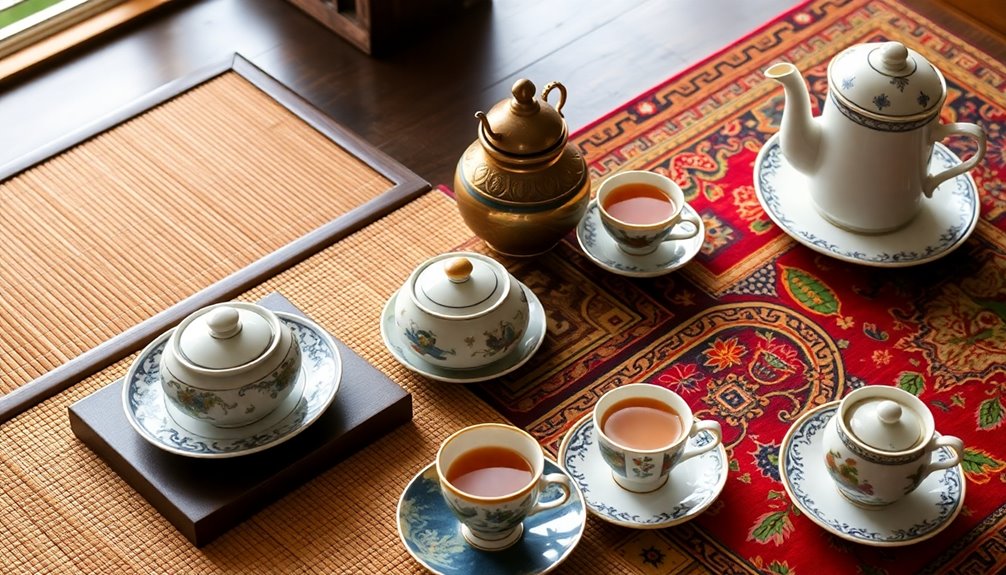
Tea serving traditions around the world offer a fascinating glimpse into different cultures and their values.
In Japan, the Japanese tea ceremony, or chanoyu, emphasizes harmony, respect, and tranquility. Here, brewing tea with matcha involves precise movements, turning the act into a meditative ritual.
In contrast, Korean tea traditions focus on casual socialization, where the drinking of tea reflects gratitude and a philosophy of savoring moments together.
Chinese tea ceremonies highlight hospitality, featuring multiple steeping rounds and elegant teaware like gaiwan and yixing teapots. The intricate process not only showcases the aroma of the tea but also fosters connections among guests.
Meanwhile, in Turkey, black tea is a staple, served in small tulip-shaped glasses that reveal its rich color and aroma, symbolizing warmth and friendship during gatherings.
Each cultural tea experience, whether it's the tea game by paying in China or enjoying tea in a wine glass in Turkey, embodies deeper social values and historical significance.
Serving Temperature Affects Flavor
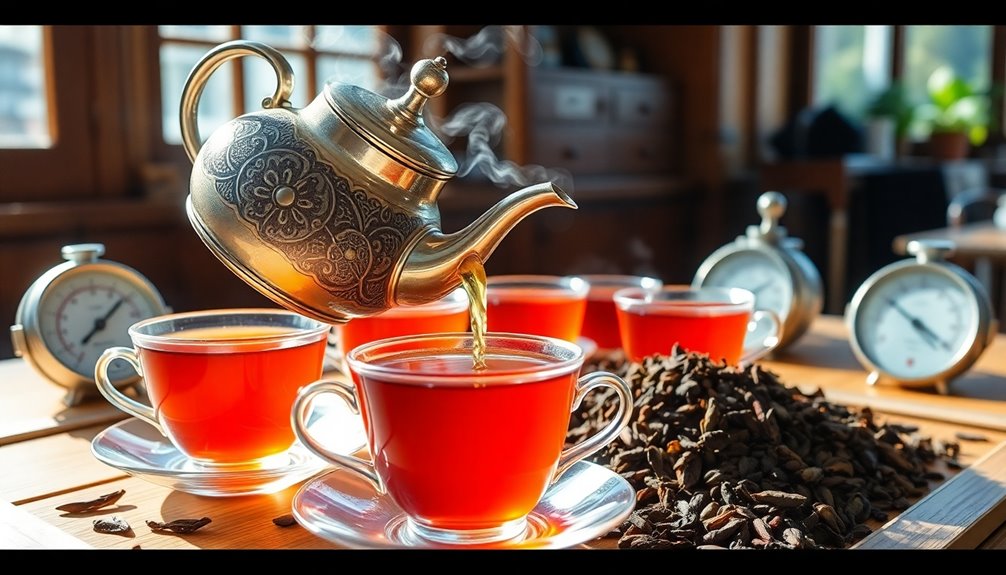
Many tea lovers may not realize how serving temperature can significantly impact the flavor of their favorite brews. The ideal serving temperature for black tea is between 200-212°F (93-100°C), which enhances its robust flavors and aroma.
Conversely, green tea is best enjoyed at a lower temperature of 160-180°F (71-82°C) to preserve its delicate taste and prevent bitterness. For oolong tea, typically served at around 185-205°F (85-96°C), the heat allows its complex flavors to shine through.
White tea, known for its light flavor profile, should be served at even lower temperatures of 160-185°F (71-85°C) to maintain its subtlety.
By paying attention to the serving temperature, you're not just influencing flavor extraction but also enhancing your overall drinking experience. If you're using loose leaf tea, remember to brew tea separately according to type to get the best results.
Making these adjustments ensures that you enjoy each tea's unique qualities, transforming your tea time into a truly pleasurable ritual. So next time you brew, keep these temperatures in mind for a delightful cup!
Tea's Impact on Social Bonding
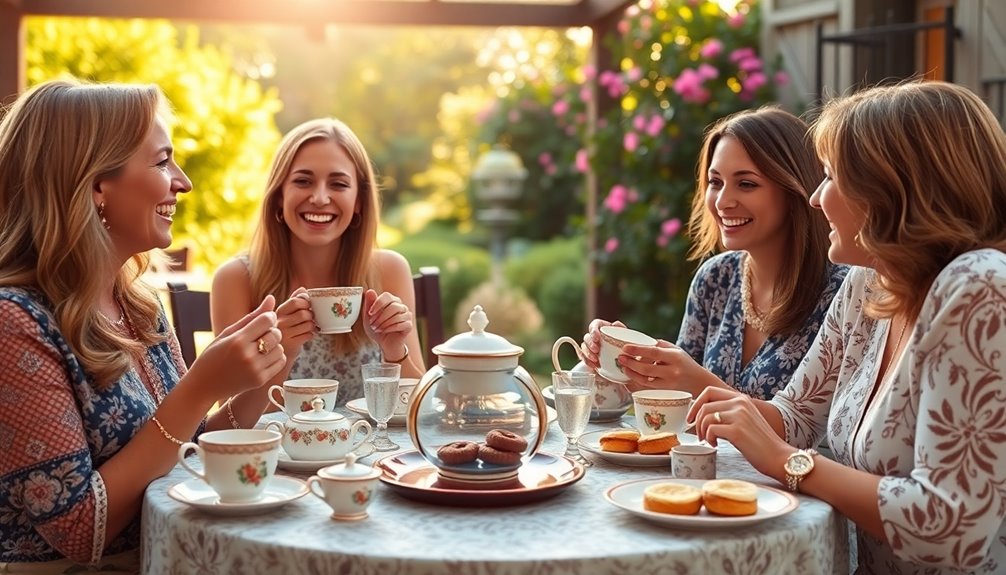
Through shared rituals and moments of pause, tea serves as a powerful social catalyst that fosters connections among individuals. The art of drinking tea goes beyond just savoring flavors; it's about creating meaningful experiences that enhance social bonding.
In cultures like Japan, tea ceremonies promote mindfulness, transforming simple gatherings into extraordinary moments that strengthen relationships.
When you engage in tea-drinking rituals, you'll notice how serving tea encourages openness and sharing experiences. This communal aspect is evident in various cultures, such as Turkish traditions, where daily black tea consumption reinforces family bonds and social ties.
Tea gatherings often involve storytelling, allowing participants to connect on a deeper level. As you sip your tea, conversations flow naturally, creating a shared experience that fosters a sense of belonging and community among everyone present.
Cultural Appropriation in Tea Practices

Engaging in tea rituals can deepen connections, but it's vital to approach these practices with sensitivity to their cultural origins.
Cultural appropriation in tea practices occurs when you adopt elements from different traditions without understanding their significance, often leading to misrepresentation. For example, the Japanese tea ceremony (chanoyu) embodies harmony and mindfulness, and taking its elements without context can diminish its elegance and cultural importance.
As specialty tea shops rise, some may gloss over the rich heritage behind various teas, focusing more on commercialization than appreciation.
It's essential to engage with and learn from the cultures that birthed these tea practices, fostering respect and authenticity in how you serve tea. Understanding the different temperatures required for brewing various teas can also enhance your mindfulness and connection to these traditions.
Practical Applications

Elevate your tea-serving skills with practical applications that enhance the overall experience for you and your guests. One elegant way to drink tea is by using glassware or vintage sherry glasses. This not only adds sophistication but also allows everyone to appreciate the color and clarity of your fresh tea.
Before brewing, pre-warm your teapot or cups by rinsing them with hot water. This helps maintain the optimal temperature for steeping, which is crucial in the art of brewing. In fact, the correct water temperature can significantly impact the flavor of your tea.
When serving tea, aim for a tea-to-water ratio of about 2 grams of loose tea leaves per 150 milliliters of water. This balance ensures a rich flavor profile, but feel free to adjust based on personal preference. If you're brewing two teas separately, monitor the different temperatures and times to achieve the best results.
Consider experimenting with unique serving styles, like chilled teas or pairing your brews with food. These techniques not only enhance the experience but also create memorable moments for your guests. Additionally, serving herbal tea can be beneficial due to its health benefits for relaxation and overall well-being.
Remember to serve tea with care, adding milk or flavorings slowly and in moderation for the desired taste. Enjoy the journey of drinking tea!
Conclusion
By mastering the art of tea serving, you not only enhance the flavor and experience but also embrace the rich traditions behind it. Remember to respect cultural practices and be mindful of the serving temperature to elevate your gatherings. As you pour each cup, you're not just sharing a drink; you're fostering connections and creating memories. So, grab your teapot, invite friends over, and let the beauty of tea bring you all closer together.


